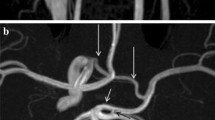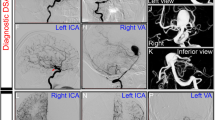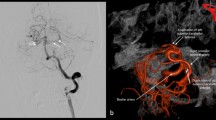Summary
Two patients with aneurysms at the termination of the basilar artery deforming the third ventricle had a clinico-radiological picture of communicating hydrocephalus. Both patients underwent ventriculo-atrial shunt operations. Case 1 died 3 months after the operation. Autopsy revealed atrophic changes of the mammillary bodies and basal ganglia. In Case 2 paroxysmal increases of CSF-pressure (plateau-waves) were recorded during the operation. Slight clinical improvement was observed as compared with the preoperative condition.
The significance of these findings are discussed in relation to the syndrome of adult “normal pressure” hydrocephalus.
Similar content being viewed by others
References
Adams, R. D., C. M. Fisher, S. Hakim, R. G. Ojemann, and W. H. Sweet, Symptomatic occult hydrocephalus with “normal” cerebrospinal fluid pressure. New Engl. J. Med.273 (1965), 117–126.
Breig, A., K. Ekbom, T. Greitz, and E. Kugelberg, Hydrocephalus due to elongated basilar artery. A new clinico-radiological syndrome. Lancet1 (1967), 874–875.
Bull, J., Massive aneurysms at the base of the brain. Brain92 (1969), 535–570.
Di Chiro, G., New radiographic and isotopic procedures in neurological diagnosis. J. Amer. med. Ass.188 (1964), 524–529.
Ekbom, K., T. Greitz, and E. Kugelberg, Hydrocephalus due to ectasia of the basilar artery. J. Neurol. Sci.8 (1969a), 465–477.
— —, M. Kalmér, J. López, and S. Ottosson, Cerebrospinal fluid pulsations in occult hydrocephalus due to ectasia of the basilar artery. Acta Neurochir.20 (1969b), 1–8.
Gordon, E., The action of drugs on the intracranial contents. Proc. IVth World Congress of Anaesthesiologists, Sept. 9–13, 1968. In: Progress in Anaesthesiology (Eds. T. B. Boulton et al.). Excerpta Medica Found., Amsterdam (1970), 60–68.
Hakim, S., and R. D. Adams, The special clinical problem of symptomatic hydrocephalus with normal cerebrospinal fluid pressure. Observations on cerebrospinal fluid hydrodynamics. J. Neurol. Sci.2 (1965), 307–327.
Ingvar, D. H., and N. A. Lassen, Methods for cerebral blood flow measurements in man. Brit. J. Anaesth.37 (1965), 216–224.
Lundberg, N., Continuous recording and control of ventricular fluid pressure in neurosurgical practice. Acta Psychiat. Scand.36 (1960), Suppl. 149.
Pudenz, R. H., F. E. Russel, A. H. Hurd, and C. H. Shelden, Ventriculo-auriculostomy. A technique for shunting cerebrospinal fluid into the right auricle. Preliminary report. J. Neurosurg.14 (1957), 171–179.
Author information
Authors and Affiliations
Rights and permissions
About this article
Cite this article
Ekbom, K., Greitz, T. Syndrome of hydrocephalus caused by saccular aneurysm of the basilar artery. Acta neurochir 24, 71–77 (1971). https://doi.org/10.1007/BF01403142
Issue Date:
DOI: https://doi.org/10.1007/BF01403142




